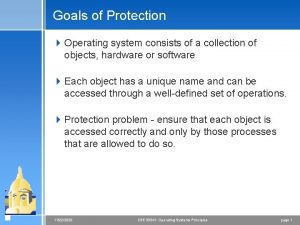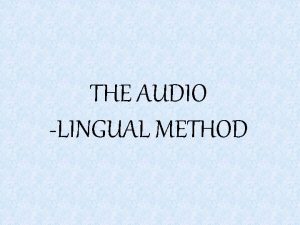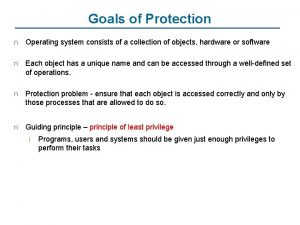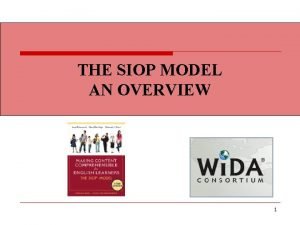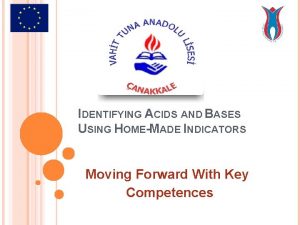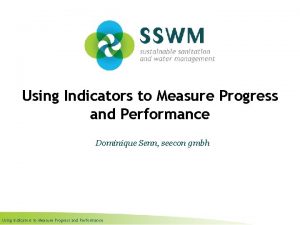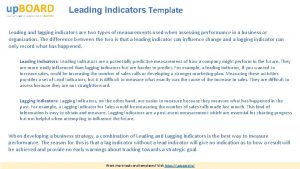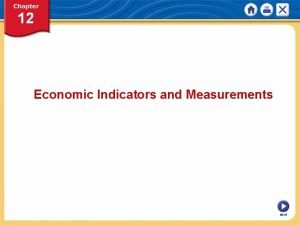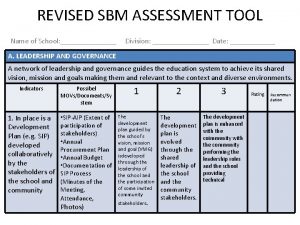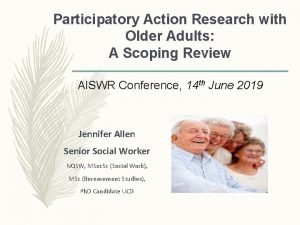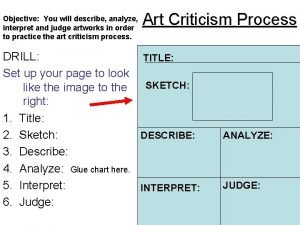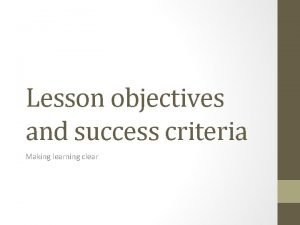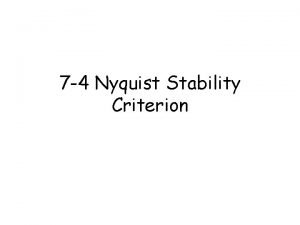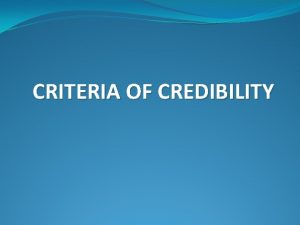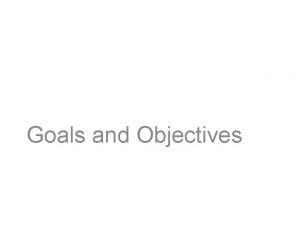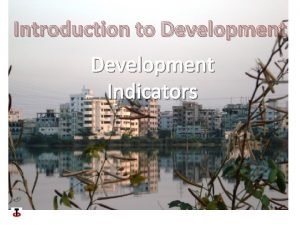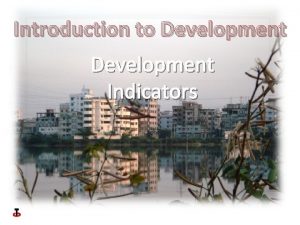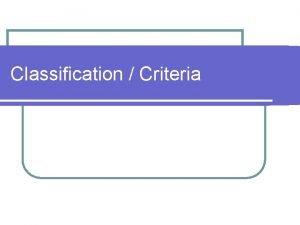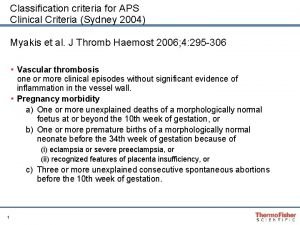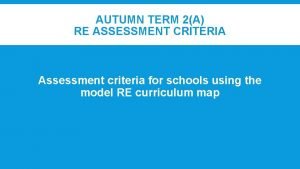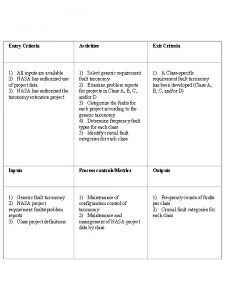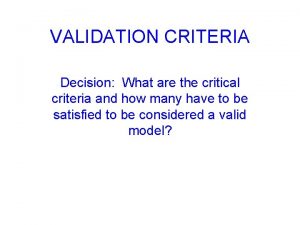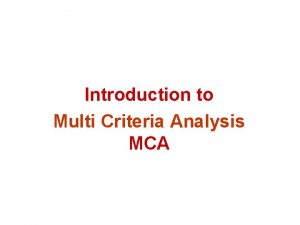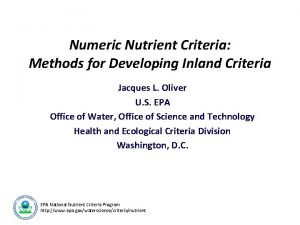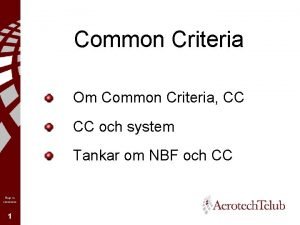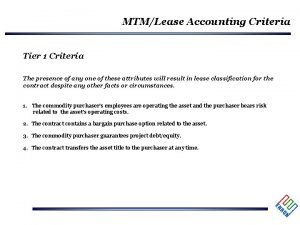Goals and Indicators Goals Principles Criteria and Indicators


























- Slides: 26

Goals and Indicators

Goals, Principles, Criteria, and Indicators § § Goal – a description of future condition community members wish to achieve Principle – a rule of conduct, esp. of right conduct Criterion – a means of judging; a test by which something can be judged Indicator – a numeric measure that provides key information about a system’s condition Sustainable Measures

Goals or Indicators Which Comes First? Goals: • provide a framework for developing indicators • provide an impetus and context for tracking, reporting, and discussing the indicators Indicators: • clarify and specify what a goal means • track movement towards or away from the goal

Goals Principles, Criteria Indicators

Aligning to sustainability Goals and indicators are like a compass: If they aren’t aligned with sustainability, there is no telling where you will end up Sustainable Measures

What Makes A “Good” Goal? • • Looks to the future Potentially measurable Potentially achievable, but not easily or automatically Reflects a broad understanding and agreement among community members of what is important to and valued by the community • Represents desired outcomes or community conditions, not the specific actions or programs that may be necessary to achieve those conditions Sustainable Measures

What Makes It A “Sustainability” Goal? • Reflects a balance between economic, social, and environmental conditions • Recognizes and accounts for long-term limits of natural, social, and built systems • Promotes inter- and intra-generational equity • Reflects a ‘big picture’ system view Sustainable Measures

System Goals Principles, Objectives, Criteria Indicators Program Goals Principles, Objectives, Criteria Indicators Action Goals Principles, Objectives, Criteria Indicators

Different Levels § System – long-term – desired conditions at the community level (Selectboard/ Town Manager/ Community) § Program – medium term – changes that occur through the development and/or implementation of programs or sets of activities (Town Committees/ Department Heads/ Local Organizations) § Action – short-term – desired effect of specific action or actions of individuals (Committee members/ Town Staff/ Community Members) Sustainable Measures

System-Program-Action System Program Action Program Action Sustainable Measures Action

Examples of Goals at Different Levels System: Maximize utilization of alternative forms of transportation (walking, bicycling, public transit, and carpools/rideshare). Program: Develop traffic policies to reduce negative impacts from vehicles and limit pavement area to the minimum necessary. Action: Implement work schedules which reduce the number of employee commute days. Sustainable Measures

Environment Air Forest Land Society Biodiversity Wetland Acres of wetland Water Quality People Water Quantity ppm of pollutant in water Economy Connections Health Gallons of water per unit of product Production Consumption Materials Use Gallons of water per resident

Sustainable System Components Environment Air Land Water Habitat Society Health Education Cooperation Economy Production Consumption Sustainable Measures

What is an indicator? § § § A way to measure, point out, or point to with more or less exactness. Something that is a sign, symptom or index of the condition of a system. A measure, typically numeric, that provides key information about a system’s condition. Sustainable Measures

Indicators • Numerical measures that provide key information about a physical, social or economic system. • Indicators are variables; data are the actual measurements or observations; targets are expected or desired indicators values. Sustainable Measures

Indicators are for: § Raising Awareness § Informing Decisions § Measuring Progress Sustainable Measures

A Good Sustainability Indicator Is a Valid Indicator That: § Measures a key sustainability issue: § – – Carrying capacity of community capital Equity (inter- and intra-generational) Long-term balance between economic, social, and environmental goals – Is relevant, understandable and useful to the community decision-making process – Generally focuses on system level rather than program or action level Sustainable Measures

Sustainable System Indicators Examples: • Number of days per year that federal standards are met for ozone, carbon monoxide and particulate matter • Volume of water in key water bodies compared to historic levels • Percent of watershed that is impervious • Percent of critical resource lands still available Sustainable Measures

Criteria for Selecting Indicators ·Is the indicator relevant to your community’s vision, issues and goals? ·Is it a system indicator that reflects sustainability concepts? ·Is it clear and easy to measure? · Is there data to track it? Sustainable Measures

Developing Sustainability Indicators • Part of the decision-making process • Continuous-loop process to relate indicators to mission, goals and targets • Need to involve everyone in the process • Aim is to promote continuous improvement in overall system Sustainable Measures

Plan Evaluate Act

Plan Evaluate Act Time Evaluate Plan Evaluate Act

Plan Using Indicators • Engage Community • Define Vision • Measure Progress Evaluate Act

Developing an Indicator System: Key Tasks • Decide on purpose, audience, and scope of indicators • Identify and review for relevance – Existing indicator projects and products – Available data sets – Potential indicator users and data owners • Generate set of potential indicators (ideal) • Evaluate relative to purpose, audience and scope • Select proposed set • Develop indicators (gather data, develop graphic and text) • Implement, evaluate effectiveness and redo as needed Sustainable Measures

Key Questions to Consider: • What is the purpose of the indicator system (raise awareness, inform decisions, monitor progress)? • Who is the audience and how will they use the indicators? • Who needs to be involved (including intended audience and keepers of the data)? • What will be the scope and boundaries of the indicator system (geographic area, topic areas)? • What will the balance be between ideal and doable? Sustainable Measures

The Process Matters! • The process by which indicators are developed is as important as the final product • Collaboration is the key because indicators must: – measure something that is publicly valued – be understood by those who will use them – be seen as credible and meaningful – be linked (conceptually and practically) to policies and actions • Process must include the decision makers and the data managers – There must be a common expectation that the indicators will be reported, discussed and linked to action on a regular basis Sustainable Measures
 Strategic goals tactical goals operational goals
Strategic goals tactical goals operational goals Strategic goals tactical goals operational goals
Strategic goals tactical goals operational goals General goals and specific goals
General goals and specific goals Examples of generic goals and product-specific goals
Examples of generic goals and product-specific goals What are protection goals and principles
What are protection goals and principles Conclusion of audio lingual method
Conclusion of audio lingual method Goals and principles of protection in os
Goals and principles of protection in os Siop and tap have similar descriptors and indicators
Siop and tap have similar descriptors and indicators Class instructional support domain
Class instructional support domain Homemade indicators for acids and bases
Homemade indicators for acids and bases Chapter 7 sports and entertainment marketing
Chapter 7 sports and entertainment marketing What are “cream” and “spiced” indicators
What are “cream” and “spiced” indicators Three visual indicators of lightning and thunderstorms
Three visual indicators of lightning and thunderstorms Leading and lagging indicators powerpoint template
Leading and lagging indicators powerpoint template Chapter 12 economic indicators and measurements
Chapter 12 economic indicators and measurements What is the inclusion and exclusion criteria in research
What is the inclusion and exclusion criteria in research Traditional and systematic review venn diagram
Traditional and systematic review venn diagram Egra arata assessment tool
Egra arata assessment tool What is the inclusion and exclusion criteria in research
What is the inclusion and exclusion criteria in research Give the nine criteria for analyzing and judging art
Give the nine criteria for analyzing and judging art Learning objectives and success criteria
Learning objectives and success criteria Thank you note to preceptor after orientation
Thank you note to preceptor after orientation Examples of learning intentions
Examples of learning intentions Net present value and other investment criteria
Net present value and other investment criteria Learning intentions and success criteria examples
Learning intentions and success criteria examples Explain nyquist stability criterion
Explain nyquist stability criterion 12 core functions of counseling
12 core functions of counseling




